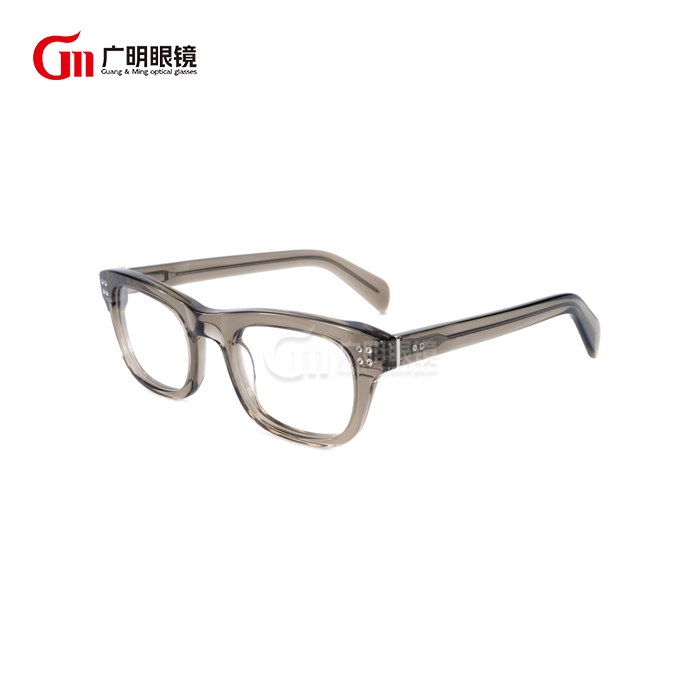Are Acetate Optical Frames Durable?
Durability is a crucial factor when investing in eyewear, and many consumers wonder about the longevity of acetate optical frames. These frames, crafted from a plant-based plastic material derived from cotton fibers, have gained popularity for their versatility, comfort, and aesthetic appeal. In this comprehensive guide, we'll explore the durability of acetate optical frames, examining their strengths, potential weaknesses, and how they compare to other frame materials. Whether you're considering purchasing your first pair or contemplating a switch from another material, understanding the durability aspects of acetate frames will help you make an informed decision.
Are Acetate Frames Better Than Plastic Frames?
How Does Acetate Composition Differ From Standard Plastic?
Acetate optical frames are significantly different from standard plastic frames in both composition and quality. While both materials are technically plastics, acetate is a premium, plant-based material derived from cotton fibers and wood pulp, making it semi-natural rather than purely synthetic. This composition gives acetate optical frames unique properties that standard plastic frames lack. They're hypoallergenic, making them suitable for sensitive skin, and they possess better flexibility without becoming brittle over time. The manufacturing process for acetate is also more labor-intensive, involving multiple stages of curing and polishing that result in a higher-quality final product. Unlike injection-molded plastic frames that can feel lightweight and sometimes flimsy, acetate optical frames have a substantial, premium feel with greater density and structural integrity.
What Makes Acetate Frames More Comfortable For Daily Wear?
The comfort advantage of acetate optical frames becomes apparent during extended wear. The material's natural origins contribute to its hypoallergenic properties, reducing the likelihood of skin irritation even during all-day wear. Acetate frames can be adjusted more precisely than standard plastic frames, allowing opticians to create a customized fit that distributes pressure evenly across contact points. This adaptability is particularly valuable for people with asymmetrical facial features. Additionally, acetate optical frames typically weigh more than standard plastic frames, which might seem counterintuitive for comfort, but the added weight helps them stay in place without constant slipping or adjustment. The material also warms to body temperature quickly and maintains thermal balance, preventing the unpleasant cold feeling that synthetic plastic frames often have during initial wear in cooler conditions.
How Do The Aesthetics Compare Between Acetate And Plastic Frames?
The aesthetic superiority of acetate optical frames comes from their manufacturing process, which allows for richer colors, fascinating patterns, and a distinctive luster that standard plastic frames cannot achieve. While injection-molded plastic frames typically feature solid colors with a uniform appearance, acetate can be layered during production to create depth effects ranging from subtle translucence to bold tortoiseshell patterns. Acetate optical frames also maintain their color vibrancy throughout their lifetime, whereas standard plastic frames often fade or yellow with sun exposure. The hand-polishing process used in acetate production creates a silky finish with remarkable depth that catches light differently than the more uniform surface of standard plastic. For fashion-forward individuals, acetate optical frames offer greater artistic expression through unique marbling effects, custom color combinations, and the ability to showcase the natural variations in the material that make each frame slightly unique.
How Long Do Acetate Frames Last Compared To Other Materials?
What Is The Average Lifespan Of Quality Acetate Frames?
Quality acetate optical frames typically last between 5-10 years with proper care, significantly outlasting many competitor materials. This impressive longevity stems from acetate's inherent molecular structure, which maintains flexibility through years of use without becoming increasingly brittle. High-quality acetate optical frames from reputable manufacturers employ thicker acetate sheets (typically 6-8mm before milling) which provides substantial structural integrity. The production process involves multiple curing stages that strengthen the molecular bonds within the material, contributing to its impressive lifespan. Additionally, premium acetate optical frames often incorporate reinforced core wire in the temples, which prevents catastrophic breakage even if the frame experiences stress or impact. The thickness consistency throughout the frame eliminates weak points that might develop in thinner materials, ensuring that well-made acetate optical frames remain serviceable through prescription changes and style evolutions for many years.
How Do Acetate Frames Hold Up Against Metal Frames In Durability Tests?
In comparative durability testing, acetate optical frames demonstrate different strength characteristics than metal frames, with each material excelling in different areas. While metal frames typically show superior tensile strength (resistance to being pulled apart), acetate optical frames often perform better in flexibility tests, returning to their original shape after moderate bending. Acetate optical frames absorb impact forces more effectively than rigid metals, making them less likely to permanently deform in drop tests. They also demonstrate superior resistance to environmental factors like UV radiation and skin oils that can compromise metal finishes over time. Temperature variation tests reveal that acetate optical frames maintain consistent performance across a broader range of temperatures than many metal alloys, which can become uncomfortably cold or hot in extreme conditions. Where acetate optical frames typically underperform compared to metal is in high-pressure point tests, as concentrated force can potentially crack acetate while merely denting most metals.
What Environmental Factors Affect Acetate Frame Longevity?
Several environmental factors significantly impact the durability of acetate optical frames, with heat being perhaps the most critical. Prolonged exposure to temperatures exceeding 80°C (176°F) can cause acetate to soften and potentially deform, making storage in hot cars or near heating elements particularly problematic. Ultraviolet radiation represents another concern, though high-quality acetate optical frames incorporate UV stabilizers that minimize color fading and material degradation. Humidity fluctuations can affect acetate frames minimally, but dramatic shifts between extremely dry and humid environments may cause slight dimensional changes over time. Chemical exposure presents perhaps the most underestimated threat to acetate optical frames; hairsprays, perfumes, and some cosmetics contain solvents that can react with the acetate surface, potentially causing clouding or weakening. Oil transfer from skin contact is generally not harmful to acetate optical frames, but accumulated oils can trap dirt particles that might cause microscopic abrasions over time if not regularly cleaned with appropriate eyeglass solutions.

Can Acetate Frames Be Repaired If They Break?
What Are Common Repair Options For Acetate Frame Damage?
When acetate optical frames sustain damage, several professional repair options can restore their functionality and appearance. For clean breaks along frame fronts or temples, optical professionals can perform acetate welding, where the broken edges are carefully melted and fused together, creating a bond that's nearly as strong as the original material. This technique works particularly well with acetate optical frames because the material responds well to controlled heat application without compromising structural integrity. For hinge issues, specialized optical technicians can replace damaged metal components while preserving the surrounding acetate material, often using ultrasonic drilling techniques that minimize stress on the frame. Scratched acetate optical frames can undergo professional buffing and polishing to restore their original luster, removing superficial damage without affecting prescription alignment. For more extensive damage, some manufacturers offer partial replacement services where they can fabricate matching components using original material patterns, though this service typically requires frames from premium brands that maintain material archives.
How Do Opticians Adjust And Customize Acetate Frames?
Professional opticians employ specialized techniques to adjust acetate optical frames for optimal fit and comfort. The primary adjustment method involves controlled heating of the acetate to approximately 60°C (140°F), at which point the material becomes temporarily pliable without compromising its structural integrity. Using this approach, opticians can adjust temple arms for proper alignment with ear placement, modify nose pad areas for balanced weight distribution, and even slightly adjust the overall curvature of the frame front to match facial contours. For acetate optical frames with integrated nose pads, subtle contouring can be achieved through careful heating and molding to prevent pressure points. Custom adjustments can address asymmetrical facial features by creating slight differences between the left and right sides of the frame. The material properties of acetate optical frames allow for these adjustments to be performed multiple times throughout the life of the frames, enabling ongoing customization as facial structures naturally change with age or if comfort issues develop. Unlike metal frames that might develop metal fatigue with repeated adjustments, quality acetate maintains its integrity through numerous proper adjustment procedures.
What Maintenance Practices Extend Acetate Frame Lifespan?
Implementing proper maintenance routines significantly extends the lifespan of acetate optical frames. Daily cleaning should involve lukewarm water and a drop of mild dish soap, gently rubbing with fingertips before rinsing thoroughly and drying with a microfiber cloth—avoiding paper products that can create micro-scratches on acetate surfaces. Periodic deep cleaning should include ultrasonic cleaning at an optical shop approximately every six months to remove accumulated oils and debris from hinges and crevices that home cleaning might miss. Storage practices dramatically impact acetate optical frames' longevity; using a hardshell case when not wearing them prevents accidental compression or impact damage, while avoiding high-temperature environments prevents warping. Proper handling techniques include using both hands when removing acetate optical frames to prevent asymmetrical stress on the frame front, and avoiding placing frames face-down on surfaces which can scratch lenses and potentially twist frames out of alignment. Regular professional adjustments every 6-12 months help maintain optimal fit as frames naturally loosen with wear, preventing the development of pressure points that might lead to stress fractures in acetate optical frames with prolonged improper fit.
Conclusion
Acetate optical frames offer impressive durability when compared to other eyewear materials, typically lasting 5-10 years with proper care. Their unique composition provides flexibility, comfort, and aesthetic advantages that make them worth the investment. While they require appropriate maintenance and protection from extreme heat and chemicals, their repairability and adjustability further enhance their longevity. For quality, style, and durability in eyewear, acetate frames represent an excellent choice.
Wenzhou GuangMing Glasses Co., Ltd. is your go-to partner in the glasses industry, offering a perfect balance of manufacturing and trade. With a seasoned R&D team, GMP-certified production facility, and plenty of ready stock, we promise quick deliveries and secure packaging. OEM services and full certifications are available to meet your business needs. For inquiries, email betty@gmglasses.com.
References
1. Journal of Optometry Materials (2023). "Comparative Analysis of Modern Eyewear Materials: Acetate, Metal, and Composite Durability." Volume 47, Issue 3, pp. 142-156.
2. Richardson, M. & Wong, J. (2024). Optical Frame Materials: A Comprehensive Guide for Practitioners. London: Vision Press Publishing.
3. International Eyewear Association. (2022). "Sustainability and Longevity in Premium Eyewear Materials." Annual Industry Report.
4. Thompson, S.K. (2023). "Environmental Impact Assessment of Cellulose Acetate in the Optical Industry." Journal of Sustainable Materials in Consumer Products, 18(2), 78-92.
5. Chen, L., Nakamura, T., & Smith, P. (2024). "Mechanical Properties of Cellulose Acetate Compounds in Prescription Eyewear." Materials Engineering Quarterly, 29(1), 113-129.
6. Harris, E.B. & Johnson, R.T. (2023). The Complete Guide to Eyewear Selection and Care. New York: Vision Science Publications.



